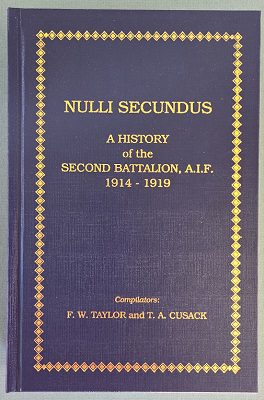Description
Title: Randwick to Hargicourt : History of the 3rd Battalion, AIF
Author: Wren, Eric
Condition: Near Mint
Edition: 2nd Edition
Publication Date: 1989
Cover: Hard Cover without Dust Jacket – 400 pages
Comments: The detailed history of the Third Battalion AIF during World War I – rare in any edition. (Note – there we less copies of the 2nd edition published than the 1st edition). Only 1 copy of this extremely scarce title is available so be quick!
The 3rd Battalion was among the first infantry units raised for the AIF during the First World War. Like the 1st, 2nd and 4th Battalions it was recruited from New South Wales and, together with these battalions, formed the 1st Brigade.
The battalion was raised within a fortnight of the declaration of war in August 1914 and embarked just two months later. After a brief stop in Albany, Western Australia, the battalion proceeded to Egypt, arriving on 2 December. The battalion took part in the ANZAC landing on 25 April 1915 as part of the second and third waves and served there until the evacuation in December. In August, the battalion took part in the attack on Lone Pine. For his valorous action in defending Sasse’s Sap at Lone Pine on 9 August, Private John Hamilton was awarded the Victoria Cross.
After the withdrawal from Gallipoli, the battalion returned to Egypt. In March 1916, it sailed for France and the Western Front. From then until 1918 the battalion took part in operations against the German Army, principally in the Somme Valley in France and around Ypres in Belgium. The battalion’s first major action in France was at Pozières in the Somme valley in July 1916. Later the battalion fought at Ypres, in Flanders, before returning to the Somme for winter.
The battalion participated in a short period of mobile operations following the German withdrawal to the Hindenburg Line in early 1917, but spent much of that year fighting in increasingly difficult conditions around Ypres. In 1918 the battalion returned to the Somme valley and helped to stop the German spring offensive in March and April. The battalion subsequently participated in the Allies’ great offensive of that year, launched east of Amiens on 8 August 1918. The advance on this day by British and empire troops was the greatest success in a single day on the Western Front, one that German General Erich Ludendorff described as “the black day of the German Army in this war”.
The battalion continued operations to late September 1918. At 11 am on 11 November 1918, the guns fell silent. The November armistice was followed by the peace treaty of Versailles signed on 28 June 1919.
Between November 1918 and May 1919 the men of the 3rd Battalion returned to Australia for demobilisation and discharge.
Includes Nominal Roll


